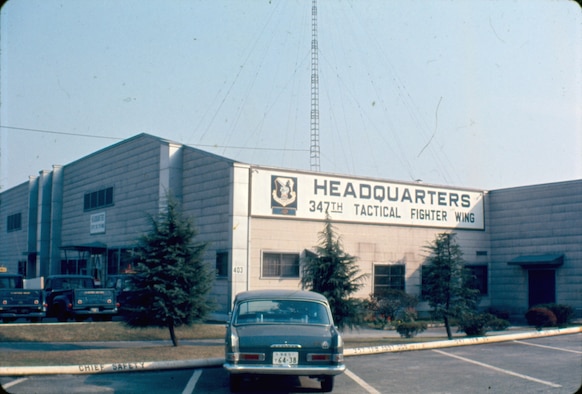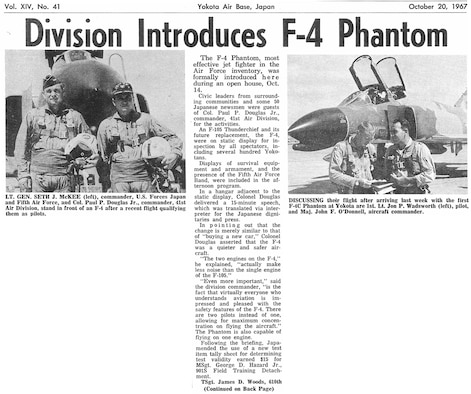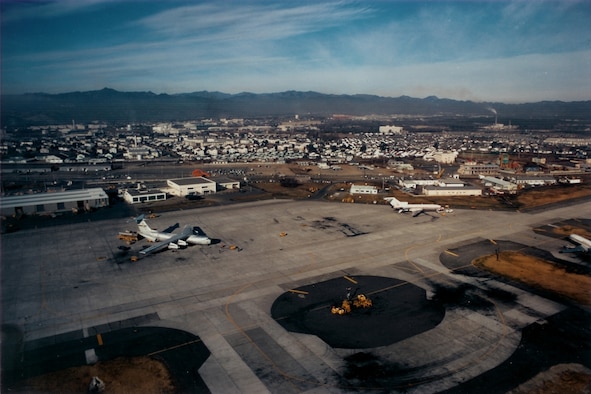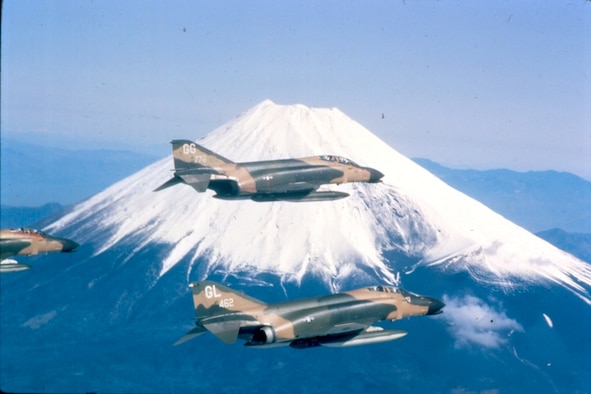Yokota A.F.B. History
Yokota Air Force Base History
By Dr. John Treiber , 374th Airlift Wing History Office / Published December 22, 2014
For more information, go to the Yokota AFB link.
A pair of Yokota-based F-105s in front of Mt. Fuji sometime in the mid-1960s. (U.S. Air Force photo courtesy of the 374 AW History Office)
YOKOTA AIR BASE, Japan -- (1959-1964) The Cold War is an amorphous event that historians date variously as having started at the end of WWII, from the president's articulation of the policy of "containment" in 1947, during the Berlin Airlift in 1948-49, or myriad other turning points in that epic struggle between the United States and the Soviet Union.
The Korean War should probably be lumped into the Cold War as well, though when examining Yokota's history it is worth analyzing Korea as a distinct event. At the other end of the spectrum the Cold War concluded in 1991 with the opening of the Berlin Wall, but at Yokota the Vietnam War was so dominant that it marked an end, or at least a pause in typical Cold War activities.
Therefore, this article shall periodize Yokota's Cold War era as the thirteen years between 1952 (about half-way through the Korean War) through 1964 when the Vietnam War was ramping up.
The variety of missions and aircraft that called the base home during this timeframe is almost overwhelming, and for those stationed at Yokota during the 1950s and into the mid-1960s the ever-looming threat of a conventional or nuclear attack was very real.
After all, Russia -- at that time the Soviet Union -- is Japan's closest neighbor, and combined with the establishment of communist China in 1949 and the aggression of North Korean toward South Korea in 1950 showed that Japan was surrounded by hostile states.
As a result during the 1950s and into the early 1960s, before the Japan Air Self Defense Force (JASDF) was fully operational, the US Air Force provided for Japan's air defense with various types of fighter jets and early warning radar systems.
As we learned in the previous article fighters from the 35th Fighter-Interceptor Wing (35 FIW) were stationed at Yokota for about three months prior to the Korean War, only to be rapidly replaced by heavy bombers for the duration of that conflict.
For a little over a year following the Korean War armistice Yokota remained almost exclusively a B-29 base. However, in August 1954 the mission changed radically with the return of the 35 FIW and three fighter squadrons.
Now flying North American F-86D "Sabres," these squadrons were part of a larger defense network with operations out of Air Force bases from Hokkaido in the north to Kyushu in the west. 35 FIW remained at Yokota until 1 October 1957 when it was inactivated.
The air defense mission was scaled back but continued under the 40th Fighter-Interceptor Squadron "Red Devils" that upgraded to F-102 Delta Daggers in 1960, and the unit was a mainstay at Yokota until 1965 when that mission was fully handed off to JASDF.
Perhaps symbolic of Yokota and the F-102's place in the Cold War, Japanese filmmakers from Toho Movie Corporation came to the base in April 1961 and filmed the jets for the monster movie Mothra. The final cut the movie only showed footage of JASDF F-86s, but it is important to note that the F-102s were originally going to play a large effort in the battle against Mothra as it devastated Tokyo.
Air defense was just one piece of the Cold War puzzle at Yokota. Along with the fighters in 1954 came the 6007th Composite Reconnaissance Group which flew RB-57A Canberras into Soviet and Chinese airspace on highly sensitive photographic missions.
This kind of important work continued at Yokota well into the 1960s under the 67th Tactical Recon Wing and other organizations, the story of which can found in the excellent history Asia from Above.
Perhaps most significantly, the Strategic Air Command or SAC -- America's dominant symbol of the Cold War -- made its appearance at the base in the mid-1950s when it established Detachment 1 of the 3rd Air Division to handle B-50, B-36, B-47, and B-52 bomber deployments to Yokota.
SAC's arrival at Yokota was facilitated by the lengthening of the runway north from 6,000 feet to its current 11,000 feet starting in the mid-1950s, a construction project that required rerouting highway Route 16 as well as the Japan National Railway's Hachiko line around the north end of the runway. This extension project was essential for the newest and largest jet aircraft being developed in the 1950s such as KC-135s, B-47s, and B-52s, followed by C-141s and C-5s in the 1960s.
The constant churn of Cold War missions and aircraft at the base continued. Along with SAC's heavy bombers Yokota also hosted a refueling squadron during the Cold War years, while the 56th Weather Reconnaissance Squadron (56 WRS) staged out of Yokota and hunted for typhoons throughout the western Pacific from the early 1950s through the 1960s using WB-29s, WB-50s, and later WC-130s, WB-47s, and WC-135s.
These weather aircraft also flew a much more sensitive but equally important mission of sampling air in the region for signs that the USSR or China had detonated a nuclear weapon. That was an unmistakably Cold War mission! Various airframes continued to make their appearance at the base during the Cold War, and of particular significance the first C-130s were stationed at Yokota in April 1961, used by the 6091st Strategic Reconnaissance Squadron.
Life at Yokota during the 1950s and through the mid-1960s, which in many respects was typical of American bases everywhere, was overshadowed by Cold War concerns. For instance, in mid-April 1952 the base hosted a very serious lecture entitled the "Big Lie" about the nature of Communism presented by Dr. M. Ernest Hall from the USAF's Japan Air Defense Force.
A filmed version of the lecture was shown in late April with a Japanese soundtrack for Japanese National employees working at Yokota. In spring 1954 fallout shelters were dug in certain parts of the base in the event of an "atomic" war, and some of these shelters were located in front of the old Yokota West Elementary School and along the fence shared with the Hachiko rail line.
The official base newspaper, at that time called the Afterburner, published numerous articles with such Cold War titles as "Communism and You" and a "Primer on Communism." The papers also ran regular quotes by General Curtis LeMay, Air Force Chief of Staff, about staying the course of freedom in the face of the Communist menace. Yes, the atmosphere at Yokota was imbued with Cold War anxieties.
By 1964, however, the Vietnam Conflict began to merge with Cold War operations at Yokota and following the Gulf of Tonkin Incident in August 1964 Yokota became fully embroiled in that seminal event. Of course the Vietnam War was also part of the Cold War, but it took on a life of its own in which Yokota was to play an outsized role.
A circa late-1960s photo of the 347th Tactical Fighter Wing headquarters building at Yokota. This structure no longer exists, but was located where Building 314 is today. (U.S. Air Force photo courtesy of the 374 AW History Office)
Yokota and the Vietnam War, 1964-71
YOKOTA AIR BASE, Japan -- January 1964 was a significant month for Yokota Air Base for it marked the space in time when the base went from primarily hosting bombers to becoming a well-known fighter base. On 8 January the 3rd Bomb Wing, which had become the base operating unit for the second time in November 1960, departed Yokota for good. Interestingly, the wing's B-57 Canberra bombers remained on station for a couple more months before being released to the New York Air National Guard and Massachusetts Air National Guard, but this was the beginning of the end of Yokota's bomber period. Meanwhile, the 441st Combat Support Group and three fighter squadrons without any fighters activated at Yokota on that same day. It will require further research to determine why the change from bombers to fighters occurred, and why the fighters did not immediately join their squadrons (the F-105s arrived in May 1964). Regardless, the newly inherited mission ensured that Yokota would end up playing a substantial role in the growing Vietnam Conflict that made heavy use of fighter aircraft.
Eight months later on 6 August 1964, just days after Gulf of Tonkin Incident that is often considered the beginning of the Vietnam Conflict, the fate of Yokota took a sharp turn in the direction of Indochina. Yes, this was still the Cold War in which Yokota would continue to play its part - the SAC bomber rotations mentioned in the previous article continued for at least a couple of years after 1964 -- but in terms of operations much of the base's focus became increasingly directed at Southeast Asia. As such, on 6 August ten of the newly arrived F-105s, plus ten KC-50 tankers from Yokota's 421st Air Refueling Squadron were sent to Southeast Asia for combat operations. This was significant, for while fighters had been stationed at Yokota as far back as 1950, during most of the Cold War the base was heavy on bombers and reconnaissance. Now things had changed: Yokota had been transformed almost overnight into a fighter base, and its squadrons would regularly deploy to Southeast Asia for the next seven years. The base converted from F-105s to F-4Cs starting in October 1967, and the 441st Combat Support Group became the 347th Tactical Fighter Wing in January 1968, but overall the fighter mission was consistent through spring 1971.
A 20 October 1967 article from the Yokota newspaper Afterburner announcing the newly arrived F-4Cs. (U.S. Air Force photo courtesy of the 374 AW History Office)
That mission finally came to an end in May 1971 due to a combination of a declining war, local opposition to excessive noise produced by the jets, and large-scale changes planned for Yokota Air Base. When the F-4s departed Yokota the base was left without fighters or bombers for the first time in its history. Moreover, when the 67th Tactical Reconnaissance Squadron and 56th Weather Reconnaissance Squadron also left Yokota in the early 1970s, two more important chapters of Yokota's flying history concluded.
While fighters have been our focus so far, of longer-lasting importance was strategic airlift operations between the US, Yokota, and Southeast Asia that were initiated during the Vietnam War. This change might be said to have begun in June 1965 when the first C-141 landed at the base. In April 1966 the Military Air Transport System (MATS, later called the Military Airlift Command or MAC, and now the Air Mobility Command or AMC) activated the 610th Military Airlift Support Squadron at Yokota for handling the massive influx of C-135s, C-141s, and contracted airliners going to and from Southeast Asia. The 65th Military Airlift Group was later activated here in August 1967, and testament to Yokota's heavily increased strategic airlift role by September 1967 ten-thousand C-141 landings and one million passengers had already been processed. This despite the fact that the main MAC terminal was still at nearby Tachikawa Air Base, whose short runway could not handle the Air Force's larger planes. Coinciding with the near end of flying operations at Tachikawa, Yokota's AMC Terminal opened in March 1969 in order to properly handle the huge amount of traffic between the US and Southeast Asia, and that was good timing since the first C-5 landed at Yokota in July 1970.
While the fighter mission came and went, it could be said that events related to the Vietnam War in part jump-started the Yokota that we know today. As noted above AMC's strategic airlift role has been at the base continuously ever the war, making it by far the longest-running operation in Yokota's history. Another long-running flying operation is the base's UH-1 helicopter mission which has changed little since the first UH-1P arrived via a C-133 "Cargomaster" in January 1971. Meanwhile the United Nations flag was first raised at Yokota in December 1969 to coincide with the move of a small Royal Thai Air Force contingent from Tachikawa Air Base to Yokota. Though the Thai airmen are gone the UN presence at Yokota continues into the present.
The 1960s and into the early 1970s was also a rich period for travelling entertainment thanks to the Vietnam War. This timeframe saw an influx of famous names to the base including John Wayne, Bob Hope, Sammy Davis Jr., Tony Bennett, Neil Sedaka, Nancy Sinatra, Johnny Cash, and various athletes such as Muhammad Ali and NFL quarterbacks Bart Starr and Joe Namath. While these people might not ring a bell with younger readers, at the time they were household names.
Of course the Vietnam War did not end in 1971, but the entrenchment of AMC operations and the departure of the fighters allowed for a completely new epoch in Yokota's history to begin, brought about by the Kanto Plain Consolidation Plan.
A November 1969 view of Yokota's newly opened MAC (AMC) Terminal. A C-141 and contract airliner sit in the foreground, and the old Yokota West housing area and some off-base American housing can be seen in the background. (U.S. Air Force photo courtesy of the 374 AW History Office)
Yokota and the Kanto Plain Consolidation Plan (KPCP), 1970 - 1980
YOKOTA AIR BASE, Japan -- (Early 1970S) Along with changes in flying operations - the move away from bombers, fighters, and reconnaissance -- by the early 1970s the Air Force had decided to return most of its properties in the Kanto Plain-to the Japanese government as part of a multiyear, multi-million dollar project called the Kanto Plain Consolidation Plan (KPCP). In the old days the greater Tokyo area was home to a number of Air Force bases and housing complexes, and in the immediate postwar period most of them were located in what we would call the countryside. However, as Japan's economy boomed starting in the mid-1950s, and especially in the 1960s, Tokyo grew exponentially and suddenly the Air Force's properties were surrounded by suburbs and cities. As growth continued the Government of Japan (GOJ) began to need for its own purposes the reasonably large tracts of land occupied by these properties.
First for the Olympics in 1964, and later for public housing projects and parks. Although it was the height of the Vietnam War, the United States and Japan worked out a deal in which the GOJ would pay for the consolidation and modernization of Yokota Air Base in exchange for most of the Air Force properties in the greater Tokyo region.
Put simply KPCP was designed to bring all Tokyo-area Air Force operations, administration, housing annexes, medical facilities and schools to Yokota Air Base, and the project was massive in scope. Flight operations ceased at nearby Tachikawa Air Base (now Showa Park) in 1969, with the remainder of that huge base released in pieces to GOJ through 1977. Prior to this there were hints that changes were coming. For instance Showa Air Station and its golf course (now the Mori Town Mall area south of the base) were returned to Japan in 1969. However, once KPCP was initiated things moved quickly as Chofu Airfield was returned to Japan in fall 1972, and Yamato Air Station, the Mito Range, South Camp Drake (which included a military golf course), Green Park housing, Grant Heights housing, and Johnson Air Station housing were all shuttered and returned to Japan in 1973.
Properties continued to change hands, and in late 1974 the Air Force turned over the Kanto Mura Housing Annex, followed by Fuchu Air Station in summer 1975, and North Camp Drake in November 1976. With the downsizing and eventual closure of Tachikawa Air Base, Yokota not only received the United Nations mission (hence the UN flag flying at the base) but also took responsibility for a number of important detached properties throughout Japan including a handful in the Kanto Plain such as the Tama Service Annex, the Tokorozawa Transmitter Site, and the Owada Transmitter Site.
The massive KPCP resulted in the residential development of the East Side where the two-story concrete Garden Units (4-unit townhouses) began opening for occupancy in 1972. Until then Yokota's east side was a largely undeveloped chunk of land that included a munitions-storage area that was completely removed in 1971 after the last F-4 fighters left. The original six East Side towers were constructed from 1973 to 1976, with the first three opening in 1974. Other important East Side facilities that opened as part of KPCP were the base hospital, the movie theater, the East Chapel, Mendel Elementary, the tennis courts, and the strip mall. KPCP also heavily impacted the built environment of the main base and west area. Significantly, the 5th Air Force moved to Yokota from Fuchu Air Station in late 1974 after its new headquarters building and general officers' quarters were completed in the heart of the base.
Other KPCP-era main-base facilities included the main chapel, Yujo Recreation Center, the Officers' and Enlisted Clubs, plus some north housing units. KPCP construction in Yokota's west area included a new commissary (now the BXtra), an exchange, (now the bowling alley), another movie theater (now used for military training), a bank building, and a gas station that was demolished in 2010.
Another important outcome of KPCP was GOJ's project to widen Route 16 into a four-lane highway, a project that finally got started in 1979 and continued throughout the 1980s. Until that time Route 16, an important road that travels north-south along the main base, was a two-lane road constantly clogged with traffic. To facilitate GOJ's plan the US Air Force gave up a significant amount of land along Yokota's western fence-line, a project that also required the demolition of many old buildings. This sort of interaction with the Japanese government and local communities has been a common theme throughout Yokota's history, but it was especially apparent during the KPCP era.
At Yokota in the 21st century there are a few vestiges of the base's first 30 years, but the fact is that 1970s Yokota under KPCP saw the closing of one distinct period and the opening of another. One symbol of this was the 5th Air Force's move from Fuchu Air Station to Yokota in November 1974.
Equally significant happened in September 1975 when Yokota received a tactical airlift mission with the arrival of the 345th Tactical Airlift Squadron. The squadron had eighteen C-130Es, and it carried out various airlift missions in the region including resupplying remote US outposts such as Iwo Jima (Iwo-To) and Marcus Island. While those particular flying missions ended in the early 1990s, tactical airlift continues into the present at Yokota under the 36th Airlift Squadron and 374th Operations Group.
The early 1970s also saw Yokota take its position as the preeminent Air Force base in the Kanto Plain. As such it was immediately involved in such historical events as Operation Baby Lift in April 1975, part of the mass movement of Vietnamese refugees following the collapse the South Vietnam.
Yokota also became fully self-contained in April 1976 when the base hospital opened and the older facility at Tachikawa was released to GOJ. Until that year Yokota residents had to leave the base and drive to the Tachikawa facility for most medical and dental care.
Beyond changes to missions and infrastructure, local relations evolved during KPCP. Until the early 1970s Tachikawa Air Base had been the main location for significant community relations events such as open houses and air shows. As a result of Yokota's newfound status, the first Friendship Festival took place at the base in September 1973. While nothing like today's annual summertime extravaganza, the 1973 festival anticipated larger events to come including the July 1976 Bicentennial open house and air show that marked the real beginning of Yokota's long Friendship Festival tradition.
Unlike most of Yokota's history which tended to unfold in an almost organic manner, the KPCP years of 1971 to 1979 were well planned and had repercussions that are still felt today.
Three Yokota-based F-4s flying in front of Mt. Fuji circa 1970. (U.S. Air Force photo courtesy of the 374 AW History Office)




